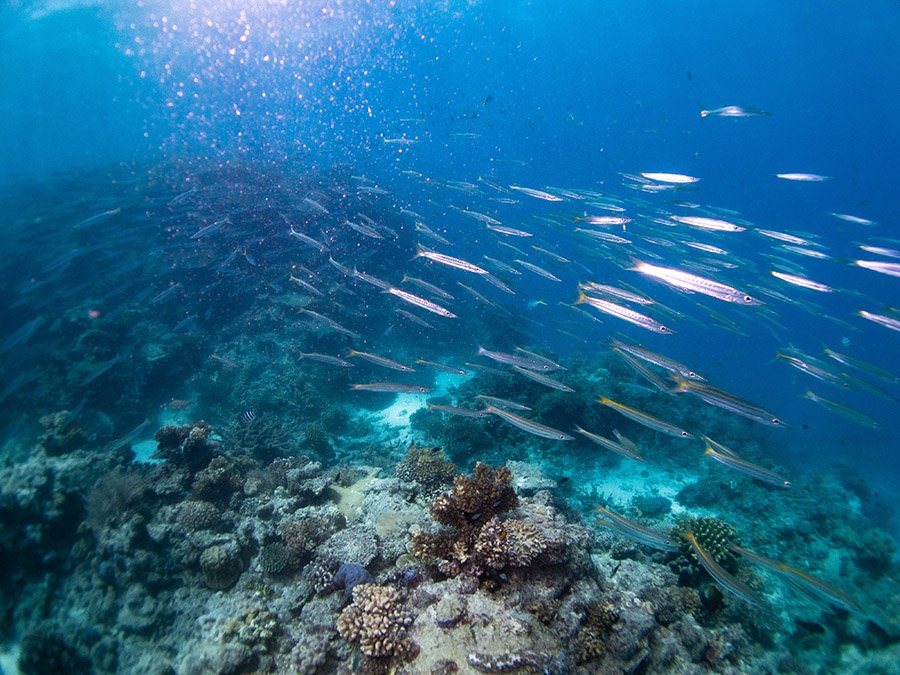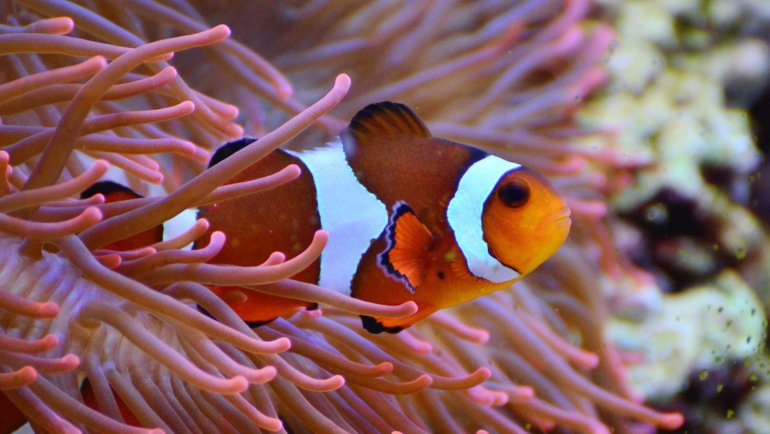Barbs, with their vibrant colors and dynamic shoaling behavior, are among the most popular fish in the aquarium hobby. Hailing primarily from freshwater habitats in Asia and Africa, barbs range from small and graceful to larger and more assertive.
Their diverse array of patterns, sizes, and behaviors make them a must-have for many aquarists, whether novice or expert. Dive into the world of barbs with this detailed article, uncovering everything from their natural habitat to their care in captivity.
The Barracuda at a Glance
Classification
| Kingdom: | Animalia |
| Phylum: | Chordata |
| Superclass: | Osteichthyes (Bony fish) |
| Class: | Actinopterygii |
| Order: | Perciformes |
| Family: | Sphyraenidae |
| Genus: | Sphyraena |
| Species: | 28 species, such as S. barracuda |
Essential Information
| Average Size: | 2-6 ft (0.6-1.8 m) with some species reaching up to 7 ft (2.1 m) |
| Average Weight: | 5-10 lbs (2.2-4.5 kg) with some individuals exceeding 50 lbs (23 kg) |
| Average Lifespan: | 10-15 years |
| Geographical Range: | Worldwide in tropical and subtropical oceans |
| Conservation Status: | Mostly Least Concern, varies by species (IUCN Red List) |
Species and Subspecies
Barracudas are classified under the genus Sphyraena, which boasts approximately 28 recognized species. While each species shares the fundamental characteristics that make a barracuda easily identifiable, there are distinct differences that make each unique:
- Great Barracuda (Sphyraena barracuda): The largest of the species, it is widespread in the tropics and can be found lurking near coral reefs and sea grasses.
- Yellowtail Barracuda (Sphyraena flavicauda): This species is recognized by its distinct yellowtail, which differentiates it from other barracudas.
- Pacific Barracuda (Sphyraena argentea): Predominantly found in the Pacific Ocean, this species tends to be slightly smaller than the great barracuda but has a similar overall appearance.
- European Barracuda (Sphyraena sphyraena): Native to the Mediterranean Sea and the eastern Atlantic Ocean, they are relatively smaller and have a more streamlined body.
While these are just a few highlighted species, each one has its unique range, size, and color patterns that differentiate it from its cousins.

Description
The barracuda’s body is built for speed. Their long, sleek, and muscular frame enables them to swim at bursts of up to 27 mph (43 km/h). Typically, barracudas are silver, aiding in camouflage against the shimmering surface of the ocean, but some species or younger individuals may showcase dark stripes or spots.
Most barracudas can grow to lengths of 2-6 ft (0.6-1.8 m), though the great barracuda, the titan of the group, can occasionally reach lengths of up to 7 ft (2.1 m) and weights of more than 50 lbs (23 kg).
Distinctive features include their pointed heads with an underbite that reveals two sets of very sharp, fang-like teeth. These teeth are perfectly designed to catch and hold onto prey, even slicing through it when necessary.
There isn’t significant sexual dimorphism within the barracuda species, which means males and females are relatively hard to distinguish based purely on external characteristics. However, like many fish species, females might grow slightly larger than their male counterparts.
Habitat and Distribution
Barracudas inhabit warmer oceans and seas worldwide. Most species are found in the Atlantic and Pacific Oceans, especially in the warmer tropical and subtropical regions.
These predators are commonly seen in shallow waters, particularly around coral reefs, mangroves, and seagrass beds, although they’re also known to venture into open seas. Some species, like the great barracuda, can even be spotted in brackish water environments such as estuaries.

Behavior
- General Behavior: Barracudas are primarily diurnal, being most active during the day. They are renowned for their incredible bursts of speed, especially when chasing prey or feeling threatened.
- Social Structure: While juvenile barracudas tend to group together in schools for safety, adults are more solitary, especially when hunting. However, it’s not uncommon to see several adults in a specific area where food is abundant.
- Communication: Barracudas rely heavily on their vision for hunting, and there isn’t significant evidence to suggest complex communication between individuals. However, like many fish species, they do possess a lateral line system, which detects changes in water pressure, enabling them to sense movement in the water around them.
- Hunting Ambush: One interesting behavior barracudas exhibit is their hunting strategy. They are known for their patience, often staying motionless in the water column or slowly cruising until they detect prey. Once they spot potential prey, they use their rapid acceleration and sharp teeth to capture it in a quick ambush.
- Mimicry: In areas frequented by humans, some barracudas have been observed following snorkelers or divers, possibly due to the shiny equipment and jewelry, which can resemble the shimmer of fish scales. While they aren’t typically aggressive towards humans, barracudas are curious creatures and may approach if something catches their eye.
Diet and Hunting/Feeding Behavior
Barracudas are carnivorous predators with a preference for fish. Their diet mainly consists of various fish species, including smaller members of their own kind. These agile hunters are also known to consume squids and crustaceans on occasion.
Equipped with a long, streamlined body and a fearsome set of sharp, fang-like teeth, barracudas are well-suited for hunting. Their approach is typically one of ambush; they rely on stealth and a sudden burst of speed to catch their prey off guard.
They often stalk their prey in open water, accelerating with explosive speed to seize their target before it can escape. Their impressive acceleration, sometimes reaching speeds up to 27 mph (43 km/h), combined with their keen eyesight, makes them formidable hunters in marine ecosystems.
Predators
Despite their position as apex predators in many marine environments, barracudas are not free from threats. Young or juvenile barracudas are vulnerable to a wide range of predators, including larger fish like tunas, mackerels, and even adult barracudas.
As they mature, their list of natural enemies diminishes, but they still face threats from larger marine predators such as sharks.
Additionally, humans pose a significant threat to barracudas, not only through fishing but also because of habitat destruction and marine pollution.

Reproduction and Life Cycle
Barracudas exhibit a fascinating reproductive cycle. These fish usually spawn between April and October, with the exact timing varying depending on the region. During the spawning season, females release their eggs into the open water, where they are fertilized externally by males.
A single female can release several thousand to over a million eggs in one season, depending on her size and age. The fertilized eggs float freely and hatch within two days, giving rise to tiny larvae. These larvae drift with ocean currents and undergo several stages of development before they resemble miniature versions of adult barracudas.
As they grow, young barracudas move to seagrass beds or mangrove areas, which offer protection from predators. These juvenile habitats are crucial for their survival during their vulnerable early stages. Adult barracudas display no parental care; once the eggs are released and fertilized, the offspring are left to fend for themselves.
Conservation and Threats
The conservation status of the barracuda varies by species and region, but many are not currently listed as endangered. However, localized declines have been noted, primarily due to overfishing and habitat degradation.
Overfishing, whether for sport or commercial purposes, poses a significant threat to some barracuda populations. Their habitats, especially the crucial juvenile areas like mangroves and seagrass beds, are also under threat from coastal development and pollution.
To counter these challenges, some regions have implemented size and bag limits for the recreational fishing of barracudas. Marine protected areas also offer refuge for barracudas, ensuring they have safe zones where they can reproduce and thrive without human interference.
Further research and monitoring are essential to determine the exact status of various barracuda species and to implement effective conservation strategies.
Fun Facts
- Barracudas have a unique set of sharp, fang-like teeth, which are perfectly designed to catch and hold onto their prey. Some of these teeth can even protrude from their mouths, giving them a menacing appearance.
- Despite their fearsome reputation, barracuda attacks on humans are rare. Most incidents occur when the fish is provoked or mistakes a shiny object, like jewelry, for a small fish.
- The great barracuda, the largest of the species, can reach speeds of up to 36 mph (58 km/h) when chasing its prey.
- Barracudas have excellent vision. Their eyes are positioned on each side of their head, providing a wide field of view which aids in hunting.
- Some indigenous cultures once used barracuda teeth as tools and even as a form of currency.
Frequently Asked Questions
Are barracudas dangerous to humans?
While barracudas have a fearsome reputation, unprovoked attacks on humans are infrequent. Most incidents occur due to provocation or when a barracuda mistakes a shiny object for prey.
How big can barracudas get?
The great barracuda, which is the largest species, can grow up to 6.6 feet (2 meters) in length and weigh as much as 110 pounds (50 kg).
Do barracudas live in groups or alone?
Juvenile barracudas often form schools, but as they mature, they tend to become more solitary, especially during hunting.
What do barracudas eat?
Barracudas primarily feed on smaller fish, which they ambush with a swift, surprise attack. Their diet includes various fish such as groupers, snappers, and anchovies.
Is it safe to eat barracuda?
While many people consume barracuda, there’s a risk of ciguatera poisoning. Ciguatera is a type of food poisoning caused by eating fish that have consumed toxins. It’s advised to be cautious and avoid eating barracuda from areas known for ciguatera outbreaks.





